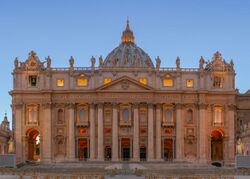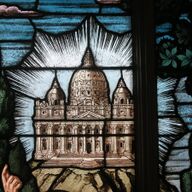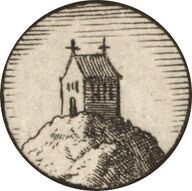Religion:Catholic ecclesiology
| Part of a series on the |
| Catholic Church |
|---|
 |
| Overview |
Catholic ecclesiology is the theological study of the Catholic Church, its nature and organization, as described in revelation or in philosophy. Such study shows a progressive development over time. Here the focus is on the time leading into and since the Second Vatican Council (1962–1965).
Communitas Perfecta
The doctrine of Communitas Perfecta ("Perfect Community") or Societas Perfecta ("Perfect Society") teaches that the Church is a self-sufficient or independent society which already has all the necessary resources and conditions to achieve its overall goal (final end) of the universal salvation of all peoples. It has historically been used in order to best define Church-State relations. Its origins are in Aristotelian political philosophy,[2] although its adaptation to ecclesiology was done by the Scholastics. The doctrine was widely used in Neoscholastic circles before the Second Vatican Council.[3]
Body of Christ
People of God
The second chapter of Lumen gentium is entitled "On the People of God". “People” avoids membership disputes: there are various ways of association; see "Body of Christ" above, which comes from this chapter. Since this chapter of Lumen gentium comes before Chapter 3 "On the Hierarchical Structure of the Church and in particular on the Episcopate", commentators note that it turns the focus from the hierarchy to the laity, declaring that the Holy Spirit "distributes special graces among the faithful of every rank. By these gifts He makes them fit and ready to undertake the various tasks and offices which contribute toward the renewal and building up of the Church" (12). This is described as a "welcoming judgment on a great mass of theoretical and practical experimentation clamoring for recognition… . The Church´s life does not flow down from Pope thru BB and clergy to a passive laity. It springs up from the grass-roots of the People of God, and the function of authority is co-ordination, authentication and, in exceptional cases, control.”[4]
Subsistence
Subsistence is the doctrine that the Church of Christ "subsists in" the Catholic Church.
Subsistit in is a term taken from Lumen gentium paragraph 8, and is intended to acknowledge that ecclesial elements of the Catholic Church can also be found elsewhere:[5]
This Church constituted and organized in the world as a society, subsists in the Catholic Church, which is governed by the successor of Peter and by the Bishops in communion with him, although many elements of sanctification and of truth are found outside its visible structure.
The theological commission has stated that "the elements which are mentioned concern not only individuals but their communities as well; in this fact precisely is located the foundation of the ecumenical movement."[5]
Those who insist that this is a development in the doctrine of the Church often remark that the Second Vatican Council did not say that the Church of Christ "is" the Catholic Church.[6] However, in another document promulgated on the same day (21 November 1964) as Lumen gentium, the Council did in fact refer to "the Holy Catholic Church, which is the Mystical Body of Christ" (Decree Orientalium ecclesiarum, 2). Here the traditional conventional expression "is" is used, whose clarity can be used to interpret the potential ambiguity of the phrase "subsists in". Then again, the Council's decree on Ecumenism stated that "all who have been justified by faith in Baptism are members of Christ's body",[7] although presumably including only those who, in good faith, do not pose an obstacle ("obex") to the reality of the Sacrament through schism or heresy, as Saint Thomas Aquinas taught. The Second Vatican Council also explicitly also states that the one true Church "is" the Catholic Church in its Decree on the Eastern Churches; thus the Council sees no essential difference, or at least views as compatible, the terms "is" and "subsists in". Claiming the identity of the Catholic Church with the body of Christ goes against the understanding presented by more liberal ecclesiologists, such as Yves Congar, George Tavard, Joseph A. Komonchak, and Francis A. Sullivan.[8]
Church Militant, Suffering, and Triumphant
Criticism of Catholic ecclesiology
Eastern Orthodox
Roger Haight characterizes the difference in ecclesiologies as "the contrast between a pope with universal jurisdiction and a combination of patriarchal superstructure with an episcopal and synodal communion ecclesiology analogous to that found in Cyprian."[9]
Anglican
Protestant
Many Christian churches have nothing approximating the Catholic Sunday celebration of the Mass as sacrifice. This leads to a different understanding of the role of the minister within these churches. At the same time, the notion of the priesthood is evolving within the Catholic church,[10] even as the understanding of sacrifice faces development.[11][12][13]
References
- ↑ Treatise on the Power and Primacy of the Pope, paragraph 22 and following
- ↑ Aristotle, Politics, Bk. I, Ch. 1
- ↑ Leo XIII, "Immortale Dei", Human and Community Christlicher review, Freiburg (1945), pp. 571–602, paragraphs 852, 857.
- ↑ Butler, Basil Christopher (1981). The Theology of Vatican II. Christian Classics. pp. 71, 76. ISBN 978-0870610622.
- ↑ 5.0 5.1 Gaillardetz, Richard R. (August 27, 2007). "The Church of Christ and the Churches: Is the Vatican retreating from ecumenism?". https://www.americamagazine.org/issue/623/article/church-christ-and-churches.
- ↑ Hebblethwaite, Peter (July 1, 1993). Paul VI: The First Modern Pope. ISBN 080910461X. https://archive.org/details/paulvifirstmoder0000hebb.
- ↑ "Unitatis redintegratio (3)". https://www.vatican.va/archive/hist_councils/ii_vatican_council/documents/vat-ii_decree_19641121_unitatis-redintegratio_en.html.
- ↑ "The Church of Christ and the Churches: Is the Vatican retreating from ecumenism?" (in en). 2007-08-27. https://www.americamagazine.org/issue/623/article/church-christ-and-churches.
- ↑ Citation error. See inline comment how to fix. [verification needed]
- ↑ "Text of Pope's Letter to Pontifical Commission for Latin America" (in en-US). Zenit. 2016-04-27. https://zenit.org/articles/text-of-popes-letter-to-pontifical-commission-for-latin-america/.
- ↑ Daly, Robert J. (February 2003). "Sacrifice Unveiled or Sacrifice Revisited: Trinitarian and Liturgical Perspectives". Theological Studies 64 (1): 24–42. doi:10.1177/004056390306400130. ISSN 0040-5639.
- ↑ Brown, Raymond E. (1990). "Pauline Theology, 82, #73". New Jerome Biblical Commentary. Pearson. pp. 1399. ISBN 0136149340.
- ↑ Kilmartin, Edward J. (1999). The Eucharist in the West, History and Theology. Collegeville, MN: Liturgical Press, 1999. pp. 381f. ISBN 0814661726..


